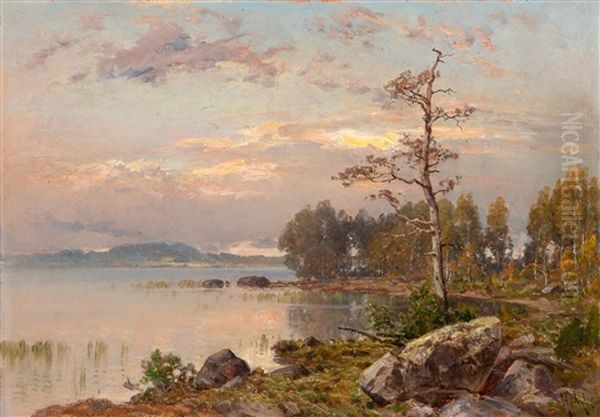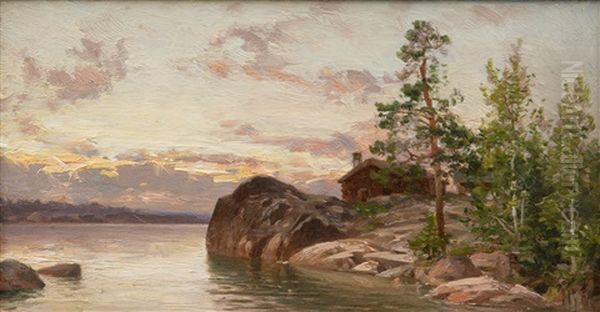
Magnus Hjalmar Munsterhjelm stands as a seminal figure in the history of Finnish art, celebrated particularly for his evocative landscape paintings. Born in 1840 and passing away in 1905, his life spanned a crucial period of national awakening and artistic development in Finland. He is widely regarded as a classic representative of Finnish landscape art, leaving behind a legacy cherished by both the art establishment and private collectors alike.
Munsterhjelm's unique contribution lies significantly in his profound and sensitive depictions of the Finnish natural environment. He possessed a remarkable ability to capture the specific moods and atmospheres of the Finnish countryside, the rugged beauty of its archipelagos, and the ethereal quality of moonlight scenes. His work resonates with a deep connection to his homeland's scenery.
Perhaps most notably, Munsterhjelm was the first major Finnish artist to truly elevate the winter landscape to a subject of primary importance. Before him, the harshness of the Nordic winter was often overlooked or depicted merely as a backdrop. Munsterhjelm, however, saw its inherent beauty and dramatic potential, rendering snow-covered fields, frozen lakes, and stark trees with both accuracy and poetic feeling. This focus cemented his reputation as an innovator within the Finnish art scene.
Artistic Education and Influences
Munsterhjelm's formal artistic training took place primarily in Germany, a common destination for aspiring Nordic artists during the 19th century. He pursued his studies in the cities of Düsseldorf and Karlsruhe, which were renowned centres for art education, particularly landscape painting. His time at the prestigious Düsseldorf Academy was especially formative, immersing him in the prevailing artistic currents of the era.
The Düsseldorf school of painting, known for its detailed realism often blended with Romantic sensibilities, clearly left its mark on Munsterhjelm. However, his artistic vision was not solely shaped by German traditions. The provided texts also indicate influences from French Plein Air painting, suggesting an awareness of the burgeoning movement towards painting outdoors to capture natural light and atmosphere more directly. This blend of influences contributed to his distinct style.

A specific influential figure mentioned is the German landscape painter Johann Wilhelm Schirmer. Evidence of this connection is found in Munsterhjelm's work titled Brook, which is noted as being based on a reproduction of Schirmer's painting Parthie an der Düsselmit Pestwurz. This act of copying or adapting a master's work was a traditional part of artistic training, indicating Munsterhjelm's engagement with established landscape conventions before developing his own path.
During his time studying, particularly in Düsseldorf, Munsterhjelm was part of a cohort of Finnish artists seeking training abroad. He formed connections with contemporaries who would also become significant figures in Finnish art history. Among those mentioned are Werner Holmberg (potentially referred to as W. Holm in one source), Fanny Churberg, and Bernt Lindholm. Munsterhjelm is noted to have followed Holmberg to Düsseldorf, suggesting Holmberg might have been a slightly senior figure or mentor at that stage. These interactions and shared experiences undoubtedly fostered a sense of community and mutual artistic development among the Finnish expatriate artists.
Signature Style and Themes
Magnus Hjalmar Munsterhjelm's artistic style is characterized by its meticulous attention to detail combined with a profound sensitivity to the nuances of light and atmosphere. He rendered the natural world with a fidelity that captured its textures and forms, yet his work transcends mere topographical accuracy. It is imbued with a lyrical quality, often evoking a sense of tranquility, melancholy, or awe inspired by nature.
His primary subject matter was the Finnish landscape in its various forms. He painted rolling countryside, dense forests, serene lakesides, and the distinctive coastal scenery of the Finnish archipelago. While adept at capturing the lushness of summer and the colours of autumn, as seen in works like Autumn morning, his most defining contributions are arguably his winter scenes and nocturnes.
As mentioned earlier, Munsterhjelm pioneered the artistic exploration of the Finnish winter. His paintings, such as October evening in the archipelago after first snow (1883), capture the crisp air, the low light, and the specific textures of snow and ice. He didn't just paint winter; he interpreted its unique character and emotional resonance for the Finnish people.
Equally significant was his fascination with moonlight. Numerous paintings, including the aptly titled Moonlight (1885), explore the transformative effects of lunar illumination on the landscape. These works often possess a quiet, mystical quality, showcasing his skill in handling subtle tonal variations and capturing the interplay of light and shadow in low-light conditions. His moonlit scenes became particularly popular and remain highly sought after.

While deeply rooted in Finnish scenery, his education and travels also exposed him to other environments. The texts note his ability to depict the lush landscapes found near Düsseldorf and the majestic mountain scenery of Southern Germany, demonstrating a versatility beyond his primary focus. However, it is his interpretation of his native Finland that forms the core of his artistic identity.
Notable Works
Several specific works by Magnus Hjalmar Munsterhjelm are highlighted, showcasing the breadth of his landscape interests:
Maantampere (1886): The title suggests a specific location or type of landscape in Finland, likely rendered with his characteristic attention to detail and atmosphere.
October evening in the archipelago after first snow (1883): This title clearly indicates his interest in transitional seasons and the specific conditions of the Finnish coast, combining his focus on archipelagos and early winter elements.
Moonlight (1885): A quintessential example of his popular nocturnes, demonstrating his mastery in capturing the effects of moonlight on the landscape.
ILTATUNNELMA: Translating roughly to "Evening Mood," this title points towards his focus on capturing specific atmospheric conditions and times of day, likely a landscape imbued with the feeling of dusk or twilight.
Autumn morning: This work highlights his ability to depict seasons other than winter, capturing the specific light and colours associated with autumn mornings in Finland.
Lähestyvä ukonilma (Approaching Thunderstorm, dated 1870-79): This painting is significant not only for its dramatic subject matter but also for its thematic connection to the work of his contemporary, Fanny Churberg. It depicts nature's more dynamic and powerful aspects.
Brook: Mentioned in the context of his education, this work based on Johann Wilhelm Schirmer's painting shows his early engagement with the German landscape tradition.
These titles, alongside the general descriptions of his work, paint a picture of an artist deeply engaged with the specificities of time, season, and place within the natural world.
Connections with Contemporaries
Munsterhjelm's artistic life was interwoven with those of other prominent figures in Finnish art and culture. His time studying abroad, particularly in Düsseldorf, placed him in direct contact with fellow Finnish painters like Werner Holmberg, Fanny Churberg, and Bernt Lindholm. These shared experiences likely fostered artistic dialogue and potentially mutual influence.
His relationship with Fanny Churberg is particularly noted through a shared interest in certain landscape themes. Both artists depicted subjects described by the term "theriakuaita," referring to the boundary zone between forest and lake or shore. Munsterhjelm's Lähestyvä ukonilma (1870-79) and Churberg's Metsäsisänsä (Forest Interior, 1871-72) are cited as examples reflecting this common thematic ground, suggesting they were exploring similar motifs, possibly influencing each other, although the provided texts find no record of direct communication or collaboration.
Munsterhjelm also engaged in artistic activities within Finland alongside his peers. He is recorded as having painted at the Vallinkoski waterfall, a known beauty spot and tourist destination in the early 20th century, in the company of Bernt Lindholm and another artist, Aukusti Uotila. This indicates collegial relationships and shared sketching or painting excursions.
Beyond the visual arts sphere, Munsterhjelm interacted with leading figures from Finnish music and literature. A specific anecdote places him spending the summer of 1902 in Tvärminne. His companions during this time included the renowned composer Jean Sibelius, and prominent writers Sakari Topelius and Juhani Aho. Their summer activities reportedly involved swimming, sailing, and social gatherings (parties). Such interactions within this creative circle undoubtedly provided stimulus, fostering friendships and potentially cross-pollinating ideas across different artistic disciplines. The location, Södergård, is also mentioned as a place frequented by Topelius and Aho, reinforcing the sense of a shared cultural milieu.
Furthermore, a familial connection existed within the art world: Magnus Hjalmar Munsterhjelm was the uncle of Ali Munsterhjelm, who also became a painter, focusing particularly on the Turku region. This family tie represents another strand in the network of artistic relationships in Finland.
Legacy and Recognition
Magnus Hjalmar Munsterhjelm's impact on Finnish art is significant and enduring. He is firmly positioned as one of the key figures of the "Golden Age of Finnish Art," a period roughly spanning the late 19th and early 20th centuries when Finnish arts flourished, often intertwined with the burgeoning sense of national identity. He shares this distinction with contemporaries like Werner Holmberg, Bernt Lindholm, and Fanny Churberg, all of whom contributed substantially to the development of a distinctly Finnish approach to landscape painting.
His work is seen as embodying the Finnish Romantic national spirit. Through his dedicated and sensitive portrayal of the nation's landscapes, particularly the previously underappreciated winter scenes, he helped shape a visual identity for Finland and fostered a deeper appreciation for its natural beauty. His paintings resonated with a public eager to see their homeland reflected in art.
Munsterhjelm's importance is reflected in the presence of his works in major public collections. The Finnish National Gallery, particularly the Ateneum Art Museum in Helsinki, holds significant examples of his paintings. His work Brook, for instance, is housed there. His paintings have been featured in prominent exhibitions, including a "Landscape Masterpieces" show at the Ateneum in 2021 and an exhibition titled "The sea gave, the sea also took away" at the Tavastia Museum in 2019, demonstrating continued curatorial and public interest long after his death.
His influence extended beyond his own lifetime, potentially through teaching or mentorship, as evidenced by the mention of a Munsterhjelm Art Centre. This centre, located on a small farm, reportedly exhibited his works alongside those of his student, Riggert Munsterhjelm, creating a dialogue between classical and modern styles within the family lineage. (The reference to a 2022 workshop suggests the centre is a modern entity celebrating his legacy).
Finally, Munsterhjelm's stature is confirmed by his inclusion in historical accounts beyond fine art. His name appears in documents related to the history of Finnish literature and photography, indicating his recognition as a significant cultural figure of his time whose work intersected with broader cultural narratives. Through his pioneering depictions of the Finnish landscape, especially winter and moonlight, Magnus Hjalmar Munsterhjelm secured a lasting place in the canon of Finnish art history.